2018 Yamaha Gp1800 Cost

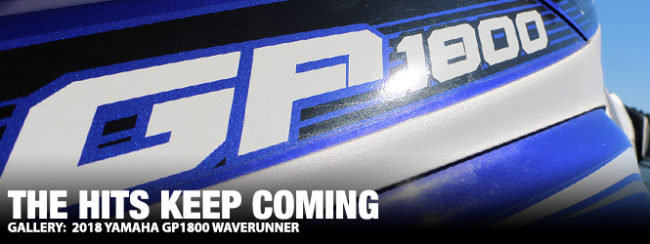
I sucked in a breath through clenched teeth as the prop bit, pushing the nose down and hard into yet another turn. Snapping the bars sharply from left to right, the muted howl of the 1,812cc Super Vortex High Output (SVHO) growled beneath the two-piece, high-bolstered bench seat. The torsional force pressed against my body, straining my arms and pulled to free my grip on the handlebars. The traction of the 160mm axial-flow pump was substantial particularly given its light weight (769-pounds dry) – this machine could hook and hook up hard. Even in spite of its shallow draft, the 11-foot long 2018 Yamaha GP1800 WaveRunner remained firmly planted to the water, that is, after toggling the electric trim down a couple of bumps. Typically, any run-of-the-mill VX WaveRunner could run at neutral trim just fine, but the GP1800 weighs a scant 2-pounds more than the VX Cruiser HO yet wields an extra 70-someodd-more horsepower, and keeping this rocket ship planted requires a bit of downforce.
Amid the heated firefight of on going horsepower wars – 300 from Sea-Doo and 310 from Kawasaki – Yamaha is perfectly content with its (unofficial) 250-horsepower from the 4-cylinder, 4-stroker SVHO engine. The dual overhead cammed, centrifugally supercharged 1.8-liter retains the crown as the largest displacement engine in the industry yet touts the lowest power output of the Big Three OE manufacturers. This though, has not dissuaded performance enthusiasts, as the SVHO has earned its keep as one of the most reliable and warmly receptive engines to aftermarket modifications. Tuners have pushed the engine's boundaries to exceed 600-horsepower through ingenious means, including turbocharging, multiple-stage nitrous systems and even high-compression E85.
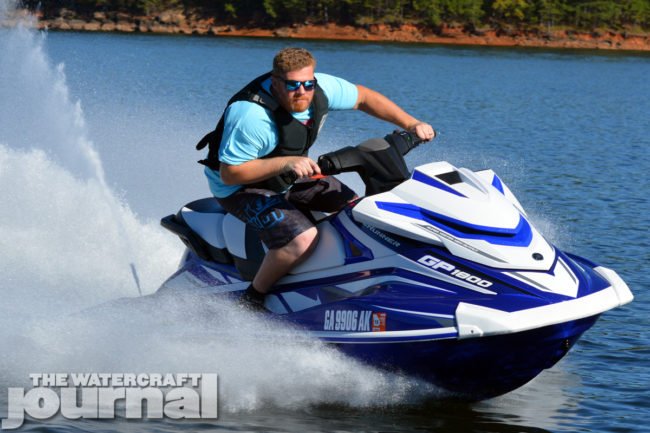
For 2018, Yamaha issued only the slightest improvements for the '18 SVHO; first, by replacing its aluminum intake manifold with a composite plastic piece (while offering some minor weight savings, it also is cheaper to produce and allows for less heat soak and better heat dispersion), and a change made to the two-piece supercharger clam shell, but it is believed to be purely for reducing manufacturing costs. The rest of the GP1800's powertrain remains identical to its inaugural 2017 model year and its fellow SVHO-equipped siblings in the FX line. All other changes for '18 have been cosmetic: a choice of either Torch Red Metallic or Team Yamaha Blue, a return to non-color-matched hand grips, and white nose and transom bumpers to match the white bond rails and graphics (with black being a larger highlight trim color for the Torch Red variant).
And why should much be changed? In its introductory year, the 2017 Yamaha GP1800 was a runaway success for the brand. Not only did it manage to sell so successfully that all units produced were sold to dealers by June of this year, but it also became the 6th highest selling personal watercraft for the year (and the only supercharged runabout to enter into the Top 10 Best Selling PWC for the year as well). Add to it an unprecedented sweep of every podium for which it was entered, including several world championships at this October's IJSBA World Finals, the continuing AquaX series and even winning the annual Long Beach-to-Catalina Offshore Championships (which up to this point had remained almost exclusively Kawasaki Ultra territory) and the GP1800 was clearly the machine to beat (or buy).

With the last few golden and tangerine leaves clinging to nearly-barren trees, I greedily embraced the opportunity to spirit away a '18 GP1800 one brisk Fall morning on Lake Allatoona, Georgia. Wisps of fog lingered spectrally over the glassy water as my brilliant blue-and-white Yamaha slit a flawless ribbon, splitting the lake's reflection in twain. Molded from Yamaha's NanoXcel2 bonding material, the GP1800 rides a little high, almost anxiously at neutral, with the nose slightly wandering, urging its rider to be pointed where to lunge and set loose. That's why trimming the nose down unlocks the GP's progressive deadrise and pronounced keel; consider the anatomy of a knife: riding at neutral trim is akin to cutting a tomato vertically. While the long straight edge of the blade might be sharp enough to adequately do the job, angling the point and rotating the tip in a fluid motion will provide a cleaner slice with more rapidity. The GP is no blunt butcher's cleaver, but a highly-crafted Ginsu.
With its 18.5-gallon tank nearly full and a not-so-svelte 235-pound rider, the GP1800 reached a peak Garmin GPS-confirmed speed of 68.4 miles per hour. Of course, achieving a top speed record was not the goal for today, but people like to ask. Rather, I was pushing for handling. Fixed points like buoys and fishing markers are ideal for pushing the GP1800, and I raced toward each one I could find with zig-zagging aplomb. Again, because of the diminutive size and weight of the GP, the WaveRunner doesn't kick up the impressive roosts that larger craft do, but of course, hydrodynamics teach us that the greater the water displacement, the more drag a vessel produces, and the GP has remarkably little drag. The Watercraft Journal painstakingly reported that the GP1800 has the brand's leading power-to-weight ratio of 0.34:1 (horsepower-to-pounds) and remains unchallenged for 2018. Any uptick in horsepower would only push that closer to 1:1.
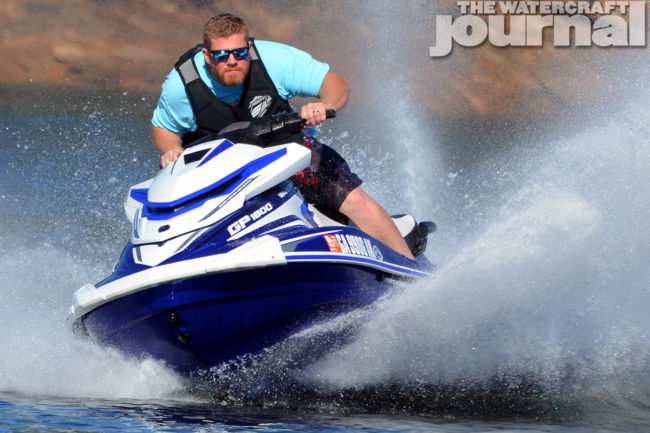
Unlike its larger FX siblings, the GP1800 is absolutely bereft of features and accessories – apart from the aforementioned electronic trim and its now standard folding swim step and RiDE dual-throttle, brake-and-reverse system. The glove box is conservative with two quasi cup holders molded into the box. The hand grips are comfortable, flat palmed, and in a natural pistol-grip configuration. The LCD screen is humble at best. A large speedometer is capped by a longitudinal tachometer and boost gauge while being flanked by a modest fuel bar and trim setting. No buttons are found to toggle through screens. No tilt or telescopic steering. No integrated cleats to tie a rope to. There's not even a small gas strut to assist in holding open the front storage bin. I mused that Yamaha built the GP1800 with the same efficiency as Carrol Shelby built his first AC Cobras. If it doesn't help the GP go faster or be safer, it's dead weight.
Saying this doesn't imply that the GP1800 is rough around the edges or slapdash in its execution. Quite the opposite. The cut-and-sew stitched seats are made from contrasting materials for better traction and ergonomics in a way that would make Gary Hart proud. The watertight, screw-top-lid watertight storage under the passenger holds tools and other valuables securely and dry. The traction mats are still made by Hydro-Turf but are the only lazer-cut mats the company makes – so don't try to order a set. You won't get one. The rich metallic paint is equal in quality to any car parked outside of an auto dealer's lot. All vibrations, chatter or rattling are eerily absent. The GP1800 is as tight as a drum. In the months since taking this '18 GP1800 home, I've never once needed to pull the drain plugs after a ride. Any water into the engine compartment has been from my over-zealous washing habits.

Priced at $13,999, the 2018 Yamaha GP1800 WaveRunner is also the most affordable supercharged performance runabout available from the manufacturer. Cargo space is on par with all other VX-based WaveRunners at 24.6 gallons, with much of it being in the bow and as mentioned, a small portion being tucked beneath the rear passenger bunk. There is no "Learner Key" or easily-accessible throttled-down setting (technically, there's a "Learning" setting through the key fob and in-dash instruments but requires the Owner's Manual to access it), so the GP1800 is truly meant to be unabashedly who it is at all times, making it as you might assume, not ideal to put your neighbor's kids on for their first time. There truly is no duplicity in this machine's presence: it wants to run and run hard. Sure, you can cruise it but you'd be one of the foolish few to purchase a thoroughbred race horse to use it for hoeing rows on your back acre. Use the machine for what it was meant to do and it'll reward you for it.
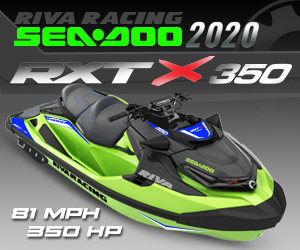


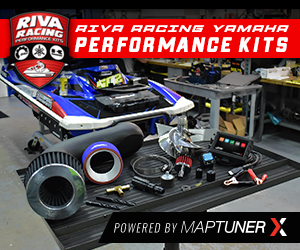
Source: https://watercraftjournal.com/the-hits-keep-coming-2018-yamaha-gp1800-waverunner/

0 Komentar